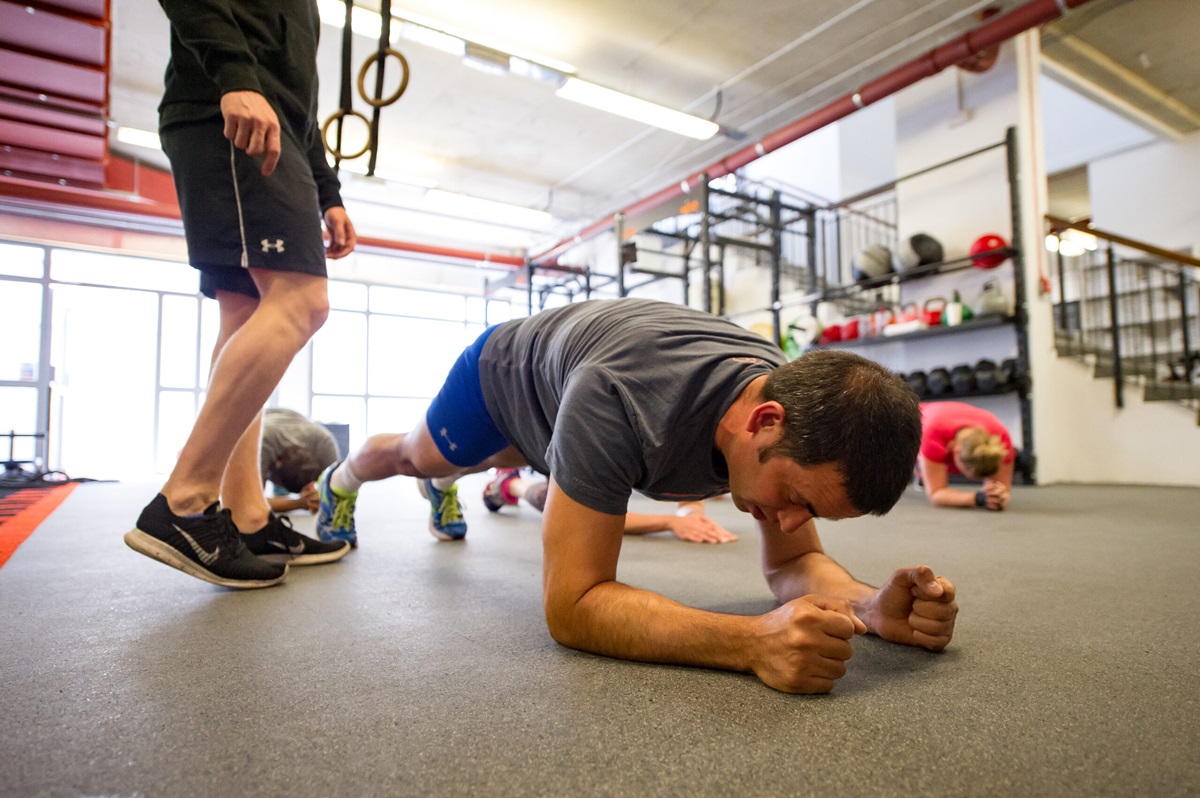

Featured
How To Build Sprint Endurance
Modified: August 21, 2023
Learn how to improve your sprint endurance with our featured guide, packed with effective training tips and exercises. Achieve your fitness goals and enhance your performance on the track.
Introduction
Welcome to the world of sprinting, where speed, power, and endurance combine to create a thrilling athletic endeavor. Whether you’re an aspiring sprinter looking to improve your performance on the track or just someone interested in building sprint endurance for overall fitness, this article is for you.
Sprinting is a high-intensity activity that requires explosive power and the ability to maintain top speed for a short distance. However, many athletes struggle with sustaining their sprinting speed over longer distances. This is where sprint endurance comes into play.
Sprint endurance is the ability to maintain a high level of speed and power over an extended period of time. It is a vital component of sprinting, as it enables athletes to perform at their best from start to finish. Whether you’re sprinting in a 100-meter race or playing a sport that requires short bursts of speed, having good sprint endurance is key to success.
Improving sprint endurance involves a combination of proper training, optimal nutrition, and adequate rest and recovery. In this article, we will explore various training principles and strategies that can help you build sprint endurance. We will also discuss the importance of warm-up and cool-down, dynamic stretching exercises, high-intensity interval training (HIIT), fartlek training, resistance training, plyometrics, and the role of nutrition in enhancing sprint endurance. So, let’s dive in and discover how you can take your sprint endurance to the next level.
Importance of Sprint Endurance
Sprint endurance is not only important for sprinters but also for athletes in various sports that require short bursts of intense speed. Here are some key reasons why sprint endurance is crucial:
- Improved performance: Building sprint endurance allows you to maintain your speed and power throughout the duration of the activity. This translates to improved performance in sprinting events, team sports, and activities that require quick bursts of speed.
- Injury prevention: Fatigue can lead to poor form and technique, increasing the risk of injury. By developing sprint endurance, you can withstand the physical demands of sprinting without compromising your form, reducing the chances of injuries.
- Enhanced cardiovascular fitness: Sprinting is an excellent cardiovascular exercise that challenges your heart and lungs. By improving your sprint endurance, you can increase your cardiovascular capacity, leading to better overall fitness.
- Explosive power: Building sprint endurance involves training the fast-twitch muscle fibers responsible for explosive power. As a result, your ability to generate quick and explosive movements will improve, allowing you to excel in various sports and activities.
- Mental resilience: Sprinting requires mental resilience and the ability to push through discomfort. Developing sprint endurance helps to strengthen your mental toughness, improving your ability to withstand fatigue and perform under pressure.
Whether you’re a sprinter aiming for the podium or an athlete seeking to enhance your performance in your respective sport, sprint endurance is a key factor that cannot be overlooked. It contributes to better performance, injury prevention, cardiovascular fitness, power development, and mental resilience.
Training Principles for Building Sprint Endurance
Building sprint endurance requires a systematic and strategic approach to training. Here are some essential principles to keep in mind:
- Progressive Overload: Gradually increasing the demands placed on your body is crucial for building sprint endurance. Start with shorter distances and slower speeds, then progressively increase the duration and intensity of your sprints over time. This gradual progression allows your body to adapt and build endurance without risking overuse injuries.
- Variation: Incorporate a variety of training techniques and drills to keep your body challenged and prevent plateaus. Mix up your workouts with interval training, fartlek training, and resistance training exercises to develop different aspects of sprint endurance.
- Specificity: Tailor your training to mimic the demands of sprinting. Focus on short, intense efforts with brief recovery periods to simulate the demands of sprinting races or sports activities. This specificity helps your body adapt to the specific demands of sprinting and improves your overall performance.
- Rest and Recovery: Allow adequate time for rest and recovery between training sessions. Rest is when your body repairs and rebuilds itself, allowing for adaptations to occur. Overtraining can lead to fatigue and hinder progress, so listen to your body and give it the rest it needs.
- Consistency: Consistency in training is key to building sprint endurance. Aim for regular workouts, sticking to a well-rounded training plan and gradually increasing the intensity and volume over time. Consistent training allows your body to adapt and make lasting improvements in sprint endurance.
By following these training principles, you can effectively build sprint endurance and improve your overall performance in sprinting events or activities that require short bursts of intense speed. Remember to consult with a professional coach or trainer to personalize your training program and ensure that you are training in a safe and effective manner.
Warm-up and Cool-down
A proper warm-up and cool-down routine are essential for preparing your body for the demands of sprinting and aiding in recovery. Let’s take a closer look at the importance of warm-up and cool-down:
Warm-up: The primary goal of a warm-up is to increase blood flow, raise body temperature, and prepare the muscles, joints, and cardiovascular system for the upcoming activity. Here are some key components of an effective warm-up for building sprint endurance:
- Dynamic Stretching: Perform dynamic stretches that target the major muscle groups involved in sprinting, such as leg swings, high knees, and walking lunges. Dynamic stretching helps to improve flexibility, increase range of motion, and activate the muscles needed for optimal performance.
- Light Aerobic Exercise: Engage in light aerobic activities like jogging or cycling to gradually increase your heart rate and warm-up your cardiovascular system. This helps to improve oxygen and nutrient delivery to the muscles, enhancing their performance.
- Activation Drills: Incorporate activation drills to activate the specific muscles used in sprinting. Examples include skipping, high-intensity butt kicks, and bounding exercises. Activation drills prepare your muscles for explosive movements and help improve muscle recruitment.
Cool-down: Cooling down after intense sprinting helps your body recover and reduces the risk of muscle soreness. Here’s what you should include in your cool-down routine:
- Slow Jog or Walk: Gradually decrease your intensity with a slow jog or walk to bring down your heart rate and allow for a gradual recovery.
- Static Stretching: Perform static stretches, holding each stretch for 15-30 seconds, to improve flexibility and restore muscle length. Focus on stretching the major muscle groups used in sprinting, such as the hamstrings, quadriceps, calves, and hip flexors.
- Foam Rolling: Use a foam roller to release tension in the muscles and promote muscle recovery. Roll each muscle group for about 1-2 minutes, applying gentle pressure and focusing on any areas of tightness or discomfort.
A proper warm-up and cool-down routine helps to enhance performance, prevent injuries, and promote faster recovery. Don’t skip these important components of your sprint endurance training!
Dynamic Stretching Exercises
Dynamic stretching exercises are an important component of your warm-up routine before sprinting. Unlike static stretching, which involves holding a stretch in a stationary position, dynamic stretches involve active movements that mimic the motions of the activity you are about to perform. Here are some dynamic stretching exercises that are particularly beneficial for building sprint endurance:
- Leg Swings: Stand next to a wall or a sturdy object and swing one leg forward and backward while keeping your torso upright. Perform 10-15 swings on each leg to warm up the hip flexors, quadriceps, and hamstrings.
- Walking Lunges: Take a big step forward with your right leg and lunge down until your right thigh is parallel to the ground. Push off with your right foot and bring your left leg forward, repeating the lunge on the other side. Perform 10-12 lunges on each leg to warm up the quadriceps, glutes, and hip flexors.
- High Knees: Stand with your feet hip-width apart and start jogging in place while lifting your knees as high as possible. Aim to bring your knees up to waist level. Perform 30 seconds to 1 minute of high knees to warm up the hip flexors and leg muscles.
- Butt Kicks: Stand with your arms extended at your sides. Start jogging in place while kicking your heels up towards your glutes, aiming to touch them with each step. Perform 30 seconds to 1 minute of butt kicks to warm up the quadriceps and calf muscles.
- Arm Circles: Stand with your feet shoulder-width apart and extend your arms straight out to the sides. Start making small circles with your arms and gradually increase the size of the circles. After 10-15 seconds, reverse the direction of the circles. Arm circles help to warm up the shoulder and upper back muscles.
Perform these dynamic stretching exercises in a controlled manner, focusing on maintaining proper form and range of motion. The goal is to activate the muscles, increase blood flow, and improve flexibility and mobility in preparation for sprinting movements.
Remember, dynamic stretching should be done prior to the workout or activity, as it helps to warm up the muscles and prepare them for the demands of sprinting. Static stretching, on the other hand, is best suited for the cool-down phase after your workout to improve flexibility and aid in muscle recovery.
High-Intensity Interval Training (HIIT)
High-Intensity Interval Training (HIIT) is a highly effective training method for building sprint endurance. It involves short bursts of intense exercise followed by periods of active recovery. HIIT workouts not only improve cardiovascular fitness but also enhance your sprinting ability by simulating the demands of sprinting. Here’s how to incorporate HIIT into your sprint endurance training:
Workout Structure:
A typical HIIT session consists of a warm-up, several intervals of high-intensity exercise, and active recovery periods. Here’s an example workout:
- Warm-up: Begin with a light aerobic activity, such as jogging or cycling, for 5-10 minutes. Gradually increase your heart rate and warm up your muscles.
- Interval Phase: Perform short bursts of high-intensity sprinting or exercises that mimic sprinting for 20-30 seconds. Go all out and give it your maximum effort during these intervals.
- Active Recovery: After each high-intensity interval, recover by performing low-intensity exercises such as walking or slow jogging for 1-2 minutes. This allows your heart rate to come down slightly and prepares you for the next interval.
- Repeat: Repeat the interval and recovery phases for a total of 4-6 rounds, gradually increasing the number of rounds as your fitness level improves.
- Cool-down: Finish the workout with a cool-down comprising light aerobic exercise and static stretching to gradually bring your heart rate down and promote muscle recovery.
Benefits of HIIT:
HIIT offers several advantages for building sprint endurance:
- Increased Anaerobic Capacity: HIIT helps improve your body’s ability to deliver and utilize oxygen during intense exercise, leading to increased anaerobic capacity. This is crucial for sustaining high-intensity efforts during sprinting.
- Improved Energy Systems: HIIT training targets both the ATP-PCr and glycolytic energy systems, which are vital for providing the energy needed for short, fast bursts of sprinting.
- Enhanced Fat Burning: HIIT workouts continue to burn calories even after you’ve finished exercising. The intense nature of HIIT stimulates metabolic adaptations that can increase fat burning during rest periods.
- Time-Efficient: HIIT workouts are typically shorter in duration compared to traditional steady-state cardio. This makes HIIT a convenient option for individuals with limited time for training.
When incorporating HIIT into your sprint endurance training, consider variables such as duration, intensity, and recovery periods. Gradually increase the intensity and duration of your intervals as your fitness improves. Always listen to your body and adjust the intensity level to ensure proper form and prevent overexertion or injury.
Adding HIIT to your training regimen can significantly enhance your sprint endurance, enabling you to perform at your best during short, intense bursts of speed.
Fartlek Training
Fartlek training is a versatile and effective method for building sprint endurance. The word “fartlek” is Swedish for “speed play,” and this type of training involves alternating between periods of fast running and slower recovery periods. Fartlek training is highly beneficial for improving your speed, endurance, and overall sprinting performance. Here’s how to incorporate fartlek training into your sprint endurance routine:
Workout Structure:
A fartlek session is characterized by its unstructured nature, allowing you to be flexible and creative with your training. Here’s a basic outline for a fartlek workout:
- Warm-up: Begin with a 5-10-minute warm-up, including light jogging, dynamic stretching exercises, and mobility drills to prepare your body for the intense workout ahead.
- Run Fast: Start with a fast running pace, around 85-90% of your maximum effort, for a designated distance or time period. This can be a sprint, a faster pace than your usual running speed, or a predetermined landmark like a tree or lamppost.
- Recover: After the fast interval, slow down to a comfortable pace for recovery. The recovery phase can be shorter or longer than the fast interval, depending on your fitness level and goals.
- Repeat: Continue alternating between fast running and recovery periods for the duration of your workout. You can vary the duration and intensity of each interval, keeping it challenging and enjoyable.
- Cool-Down: Conclude your fartlek session with a 5-10 minute cool-down, including light jogging and static stretching to help your body recover.
Benefits of Fartlek Training:
Fartlek training offers several benefits for sprint endurance:
- Improved Speed and Endurance: The alternation between fast bursts and recovery periods helps to improve both your anaerobic and aerobic capacity, enhancing your speed and endurance in sprinting.
- Mimics Real-World Conditions: Fartlek training simulates the unpredictable nature of actual races or sports activities, where sprinters need to adjust their speed and maintain a high level of endurance throughout varying terrain or game situations.
- Mental Strength: Fartlek challenges your mental resilience by forcing you to push through discomfort during the demanding fast intervals.
- Variety and Enjoyment: Fartlek workouts offer variety and flexibility, making them enjoyable and engaging. The ability to choose your running pace and routes adds an element of playfulness to your training.
Remember, fartlek training can be adapted to your fitness level, goals, and preferences. As you progress, you can increase the speed, distance, or number of intervals to continue challenging yourself and improving your sprint endurance.
By incorporating fartlek training into your sprint endurance routine, you’ll develop greater speed, endurance, and mental toughness, preparing you to excel in sprinting or any activity requiring short bursts of intense effort.
Resistance Training for Sprint Endurance
Resistance training is a vital component of building sprint endurance. It helps develop the strength, power, and muscular endurance necessary for maintaining speed and power throughout the duration of a sprint. Incorporating resistance training exercises into your sprint endurance routine can have significant benefits for your performance. Here’s how to effectively implement resistance training:
Exercises to Include:
When selecting exercises for resistance training, focus on compound movements that target multiple muscle groups simultaneously. Here are some key exercises to include in your routine:
- Squats: Squats are a fundamental exercise for developing lower body strength and power. They target the quadriceps, hamstrings, glutes, and calves, all muscles essential for sprinting.
- Lunges: Lunges strengthen the legs and improve stability, replicating the movements involved in sprinting. Perform walking lunges, reverse lunges, or stationary lunges to target different muscle groups.
- Deadlifts: Deadlifts target the muscles of the posterior chain, including the hamstrings, glutes, lower back, and grip strength. They improve overall strength and power, essential for sprinting.
- Calf Raises: Strong and powerful calves contribute to optimal push-off during sprinting. Perform standing calf raises or seated calf raises to target this muscle group.
- Explosive Exercises: Plyometric exercises such as box jumps, squat jumps, and medicine ball throws help develop explosive power and fast-twitch muscle fibers, directly benefiting sprinting performance.
Important Considerations:
When incorporating resistance training into your sprint endurance routine, keep the following considerations in mind:
- Form and Technique: Maintain proper form and technique during all resistance exercises to ensure effectiveness and reduce the risk of injury. If unsure, seek guidance from a qualified trainer or coach.
- Progressive Overload: Gradually increase the amount of weight or resistance as your strength and endurance improve. This progressive overload stimulates muscle adaptation and continuous improvement.
- Balance and Full-Body Training: While lower body exercises are crucial for sprinting, don’t neglect the upper body. A balanced and full-body training program helps maintain overall muscular balance and improves total-body coordination.
- Recovery and Rest: Allow adequate time for recovery between resistance training sessions. This ensures optimal muscle repair and growth, while reducing the risk of overtraining and injury.
Integrating resistance training into your sprint endurance routine will enhance your strength, power, and muscular endurance, ultimately improving your ability to perform at your best during sprinting activities.
Plyometric Training
Plyometric training is a dynamic and explosive form of exercise that can greatly enhance your sprint endurance. It involves quick, powerful movements that target the stretch-shortening cycle of muscles, improving your ability to generate maximum force and power in a short amount of time. Incorporating plyometric training into your sprint endurance routine can lead to significant improvements in speed, power, and overall performance. Here’s how to effectively incorporate plyometric training:
Exercises to Include:
When designing your plyometric training routine, focus on exercises that target the lower body and mimic the explosive movements involved in sprinting. Here are some key plyometric exercises to include:
- Box Jumps: Stand in front of a sturdy box and explosively jump onto it, landing with both feet on the box and then stepping or jumping back down. Box jumps strengthen the leg muscles and improve power and explosiveness.
- Squat Jumps: Begin in a squat position and explosively jump as high as possible, extending your hips and knees. Land softly and immediately descend back into a squat. Squat jumps develop lower body power and explosiveness.
- Lateral Bounds: Start in a semi-squat position and explosively jump laterally, pushing off with one foot and landing on the other. Repeat side to side, emphasizing power and quickness. Lateral bounds improve agility and lateral power for enhanced sprinting performance.
- Medicine Ball Throws: Using a weighted medicine ball, perform explosive movements such as overhead throws, chest passes, or rotational throws. Medicine ball throws develop upper body power and enhance overall explosiveness.
- Depth Jumps: Stand on an elevated platform, step off, and upon landing, immediately jump vertically as explosively as possible. Depth jumps train the stretch-shortening cycle and develop reactive strength.
Important Considerations:
When incorporating plyometric training into your sprint endurance routine, it’s important to keep the following considerations in mind:
- Proper Technique: Focus on maintaining good form and technique during all plyometric exercises to maximize effectiveness and minimize the risk of injury. Start with lower-intensity variations and progress as your skill and strength improve.
- Appropriate Volume and Intensity: Begin with a manageable volume and intensity of plyometric exercises, gradually increasing as your body adapts and becomes more resilient. Listen to your body and avoid overexertion.
- Recovery and Rest: Allow for sufficient rest and recovery between plyometric training sessions. This allows your muscles and connective tissues to repair and adapt, reducing the risk of overuse injuries.
- Progression: Continuously challenge yourself by progressively increasing the difficulty, intensity, or complexity of plyometric exercises. This helps to stimulate adaptation and ensures continued improvement.
By incorporating plyometric training into your sprint endurance routine, you can enhance your explosive power, improve your ability to generate force quickly, and ultimately achieve better sprinting performance.
Recovery and Rest Days
Recovery and rest days are crucial components of any sprint endurance training program. While it’s important to push yourself during workouts to build sprint endurance, it’s equally important to allow your body time to recover and rebuild. Adequate recovery not only helps prevent overtraining but also promotes optimal performance and reduces the risk of injury. Here’s why recovery and rest days are essential:
Muscle Repair and Growth:
Intense sprinting workouts place stress on your muscles, causing microscopic damage to the muscle fibers. Rest and recovery days allow for the repair and rebuilding of these muscles. During these periods, the body initiates protein synthesis to repair damaged tissue and build stronger muscle fibers, contributing to increased sprint endurance over time.
Energy Restoration:
Sprinting requires explosive energy production, rapidly depleting glycogen stores in the muscles. Rest and recovery days give your body the chance to restore glycogen levels, replenishing the energy needed for future workouts. This helps ensure that you have enough fuel in the tank for high-intensity training sessions.
Injury Prevention:
Continuous intense training without sufficient recovery can lead to overuse injuries and fatigue. Rest days allow your muscles, tendons, and ligaments to repair and strengthen, reducing the risk of injuries such as strains, sprains, and tendonitis. Building adequate recovery time into your training program is vital for long-term injury prevention.
Reduced Fatigue and Improved Performance:
Rest and recovery days alleviate accumulated physical and mental fatigue. Continuous high-intensity training can lead to a decline in performance, as the body becomes fatigued and the risk of burnout increases. Rest days give your body time to recharge, optimizing your performance during subsequent training sessions.
How to Incorporate Recovery and Rest Days:
Plan designated rest days into your sprint endurance training program. These days should be fully dedicated to rest and rejuvenation, allowing your body to recover from the demands of training. Activities such as light stretching, gentle yoga, or low-intensity activities can promote blood circulation and relaxation. However, avoid intense workouts on rest days to ensure proper recovery.
Additionally, listen to your body and pay attention to any signs of overtraining, such as excessive fatigue, persistent muscle soreness, or a decline in performance. Adjust your training schedule as needed, incorporating additional rest days when necessary to prevent overexertion and promote proper recovery.
Remember, rest and recovery are essential for optimizing sprint endurance and overall performance. Prioritize these periods of rest to allow your body to heal, adapt, and come back stronger for future training sessions.
Nutrition for Sprint Endurance
Nutrition plays a vital role in fueling your body for optimal sprint endurance performance. The right balance of nutrients and proper hydration not only provides the energy needed for intense workouts but also supports muscle recovery, aids in injury prevention, and enhances overall sprinting performance. Here are some key nutrition considerations for building sprint endurance:
Macronutrients:
Macronutrients, including carbohydrates, protein, and fats, are crucial for sprinters. Here’s how they contribute to your sprint endurance training:
- Carbohydrates: Carbohydrates are the primary source of energy for sprinting. Aim to consume complex carbohydrates, such as whole grains, fruits, and vegetables, to provide sustained energy for intense workouts. Consuming carbs before and after training helps replenish glycogen stores.
- Protein: Protein is essential for muscle repair and growth. Include lean sources of protein, such as chicken, fish, eggs, and legumes, in your meals to aid in muscle recovery after intense training. Aim to consume protein within 30 minutes to an hour post-workout for optimal recovery.
- Fats: Healthy fats, such as avocados, nuts, seeds, and olive oil, provide the body with a concentrated source of energy. Including moderate amounts of healthy fats in your diet supports overall health and helps maintain hormone balance.
Micronutrients and Hydration:
Micronutrients, including vitamins and minerals, are essential for maintaining overall health and supporting physical performance. Additionally, proper hydration is crucial for optimal sprint endurance. Here’s what you need to consider:
- Hydration: Stay adequately hydrated before, during, and after your workouts. Dehydration can negatively impact performance and lead to muscle cramps and fatigue. Aim to drink water consistently throughout the day and consider sports drinks for longer, more intense training sessions to replenish electrolytes.
- Micronutrients: Consume a variety of fruits and vegetables to ensure an adequate intake of vitamins and minerals. These nutrients play a role in energy production, muscle function, and immune system support.
Timing and Meal Composition:
Proper timing of meals and snacks can optimize fuel availability for workouts and support muscle recovery. Consider these guidelines:
- Pre-Workout: Consume a carbohydrate-rich meal or snack 1-2 hours before your training session to provide sustained energy. Including a small amount of protein can also help support muscle recovery during exercise.
- Post-Workout: Consume a combination of carbohydrates and protein within 30 minutes to an hour after your workout to replenish glycogen stores and support muscle repair. This can be a balanced meal or a protein-rich snack.
- Throughout the Day: Nourish your body with regular, balanced meals and snacks throughout the day to provide a steady supply of energy and support muscle recovery.
Remember, individual nutrition needs may vary, so it’s important to listen to your body and make adjustments based on personal preferences and specific dietary needs. Consult with a registered dietitian or nutritionist for personalized nutrition guidance to optimize your sprint endurance performance.
Hydration and Electrolyte Balance
Proper hydration and electrolyte balance are crucial for optimal sprint endurance performance. Sprinting places high demands on the body, leading to increased sweat and fluid loss, which can negatively impact performance and hinder recovery. Here’s why hydration and electrolyte balance are important and how to maintain them:
The Importance of Hydration:
Staying adequately hydrated is essential for sprinters. Water plays numerous roles in the body, including regulating body temperature, delivering nutrients to the muscles, and removing waste products. Here’s why hydration matters:
- Optimal Performance: Being well-hydrated enhances physical performance, as dehydration can lead to fatigue, decreased cognitive function, and impaired coordination.
- Prevention of Heat-related Injuries: Sprinting generates heat, and proper hydration helps regulate body temperature and prevent heat-related injuries, such as heat exhaustion or heat stroke.
- Muscle Recovery: Hydration supports muscle recovery by helping to transport nutrients to the muscles and removing metabolic waste products, reducing the risk of muscle cramps and soreness.
- Joint Lubrication: Sufficient hydration helps to lubricate joints and prevent joint-related discomfort during intense sprinting activities.
Electrolytes and Sprint Endurance:
Electrolytes are minerals that help regulate fluid balance, muscle function, and nerve impulses in the body. Important electrolytes include sodium, potassium, calcium, and magnesium. During intense exercise, electrolytes are lost through sweat. Here’s why maintaining electrolyte balance matters:
- Fluid Balance: Electrolytes help maintain proper fluid balance in the body, optimizing hydration and facilitating efficient muscle function.
- Prevention of Muscle Cramps: Proper electrolyte balance, particularly sodium and potassium, helps prevent muscle cramps during intense exercise.
- Nerve and Muscle Function: Electrolytes are essential for nerve conduction and muscle contraction, enabling efficient coordination and power during sprinting.
How to Maintain Hydration and Electrolyte Balance:
Here are some guidelines to help maintain proper hydration and electrolyte balance during sprinting:
- Drink Fluids Consistently: Sip water throughout the day to maintain hydration levels. Pay attention to the color of your urine; light yellow indicates good hydration, while darker shades might indicate dehydration.
- Pre-Workout Hydration: Consume water or a sports drink 2-3 hours before training to ensure proper hydration levels before starting your sprinting workout.
- During Training: Drink water or a sports drink at regular intervals during your training session to replace fluids lost through sweat. For longer and more intense sessions, choose a sports drink that replenishes both fluids and electrolytes.
- Post-Workout Hydration: Replenish fluids and electrolytes after your training session by consuming water, a sports drink, or electrolyte-rich foods such as fruits, vegetables, or coconut water.
- Electrolyte Supplementation: During prolonged and intense exercise, electrolyte supplementation through sports drinks, electrolyte powders, or electrolyte tablets can help maintain proper electrolyte balance.
Remember, individual hydration needs may vary based on factors such as body size, climate, and exercise intensity. Monitor your hydration levels, pay attention to your body’s signals, and adjust your fluid intake accordingly to support optimal sprint endurance performance.
Monitoring Progress and Adjusting Training Program
Monitoring your progress and making necessary adjustments to your sprint endurance training program are essential for continual improvement and optimal performance. Monitoring allows you to assess your progress, identify areas of improvement, and make strategic changes to your training routine. Here’s how to effectively monitor progress and adjust your training program:
Track Your Performance:
Keeping track of key performance indicators allows you to objectively measure your progress. Here are some metrics to consider:
- Time: Monitor the time it takes you to complete a specific distance or sprint interval. This can help you track improvements in speed and overall sprint performance.
- Distance: Measure the distance covered during training sessions to track your overall endurance and assess improvements over time.
- Heart Rate: Monitor your heart rate during sprints and recovery periods to gauge your cardiovascular fitness level and assess your body’s responses to training intensity.
- Rating of Perceived Exertion (RPE): Use a scale of 1-10 to rate how hard you perceive your effort during training sessions. This subjective measure can help you gauge the intensity and adjust your training accordingly.
Listen to Your Body:
Pay attention to how your body feels during and after training sessions. This includes monitoring your level of fatigue, muscle soreness, and any signs of overuse or injury. Listening to your body allows you to make informed decisions about training volume, intensity, and the need for rest or recovery.
Progression and Periodization:
Gradual progression and periodization are important components of any sprint endurance training program. Here’s how to incorporate them:
- Progressive Overload: Continually challenge yourself by gradually increasing the intensity, duration, or frequency of your sprint training sessions. This progressive overload stimulates adaptations and prevents plateauing.
- Periodization: Organize your training into distinct periods or phases. Common periods include off-season, pre-season, and competition phase. Each phase has specific training goals and allows for planned variations in intensity and volume to avoid overtraining and maximize performance during peak periods.
Adjusting Your Training Program:
Based on your progress and evaluation, you may need to make adjustments to your training program. Here’s how:
- Intensify or Increase Volume: If progress stalls or your goals require further improvement, consider increasing the intensity or volume of your sprint training sessions gradually.
- Modify Training Techniques: Experiment with different training techniques such as interval variations, hill sprints, or tempo runs to keep your training challenging and stimulate further improvements.
- Address Weaknesses: Identify areas of weakness and incorporate specific exercises or drills to target those areas. This can help you improve your overall sprint endurance performance.
- Recovery and Rest: Adjust your training program to include sufficient rest and recovery time. Adding rest days or reducing training volume can prevent overtraining, reduce the risk of injury, and improve performance.
Regularly evaluate your progress, make adjustments as needed, and seek guidance from a qualified coach or trainer to help you fine-tune your program. Remember, a training program that is flexible and adaptable will allow for continual growth and improvement in sprint endurance.
Conclusion
Building sprint endurance is a multi-faceted process that involves proper training, nutrition, hydration, and recovery. By implementing the training principles discussed in this article, such as progressive overload, variation, specificity, and consistency, you can make significant improvements in your sprint endurance performance.
Remember to warm up properly before your training sessions, incorporating dynamic stretching exercises to prepare your muscles and joints for the demands of sprinting. High-intensity interval training (HIIT) and fartlek training are effective methods for developing sprint endurance, while resistance training and plyometric exercises improve strength, power, and explosiveness.
Nutrition plays a crucial role in fueling your body for the demands of sprinting. Ensure you consume a balanced diet with adequate carbohydrates, protein, and healthy fats. Hydration and electrolyte balance are equally important, especially during intense training sessions, to maintain energy levels, prevent muscle cramps, and support optimal performance.
Monitoring your progress, listening to your body, and making adjustments to your training program are essential for continued improvement. Regularly track performance metrics, assess your body’s responses, and adjust training volume, intensity, and techniques accordingly. Emphasize proper rest and recovery to prevent overtraining and promote muscle repair and growth.
By incorporating these principles and strategies into your sprint endurance training, you can enhance your speed, power, and endurance on the track or in any activity that requires short bursts of intense speed. Stay consistent, stay dedicated, and enjoy the journey of building sprint endurance to achieve your personal best.









